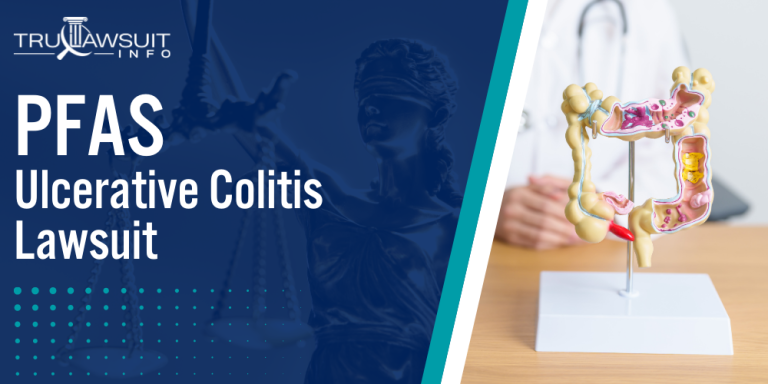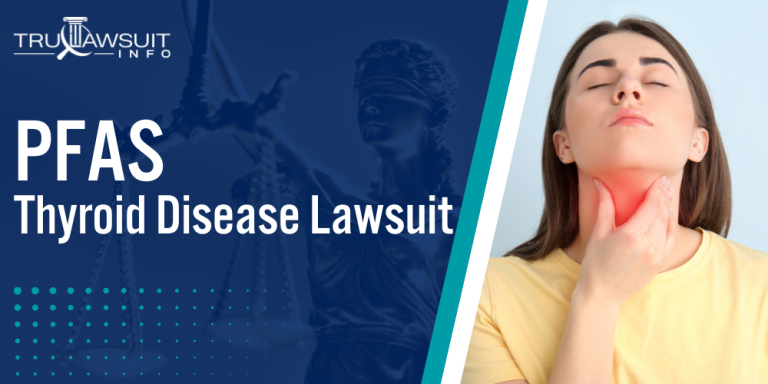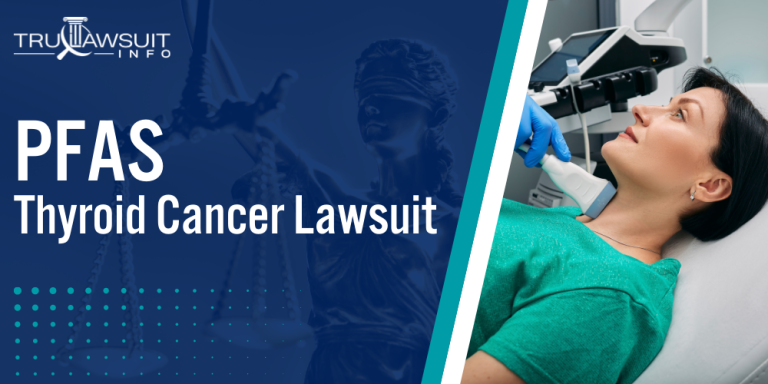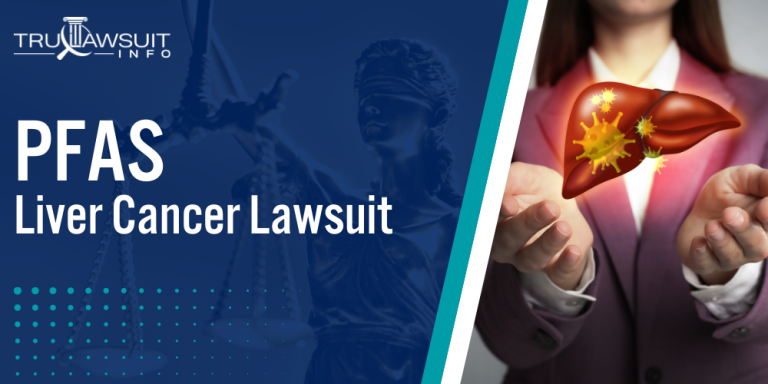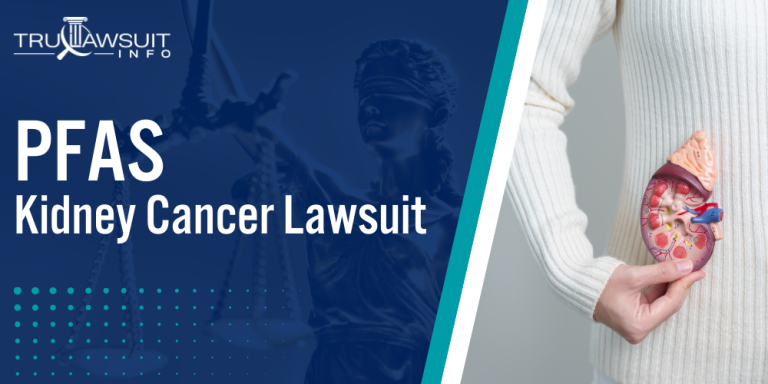PCB Contamination: Pursuing Environmental Justice
Key Takeaways:
- Changes to PCB regulations were recently announced in an effort to improve the effectiveness of the PCB Cleanup and Disposal Program under the Toxic Substances Control Act.
- The Environmental Protection Agency (EPA) classifies PCBs as probable human carcinogens, reflecting the serious implications of PCB contamination.
- Efforts to manage PCBs and reduce contamination must be thorough, incorporating strategies for prevention, cleanup, and public education on the issue.
Overview of PCB Contamination
On this page, we’ll discuss an overview of PCB contamination, environmental impacts of PCB contamination, strategies to address PCB contamination under the Toxic Substances Control Act, and much more.
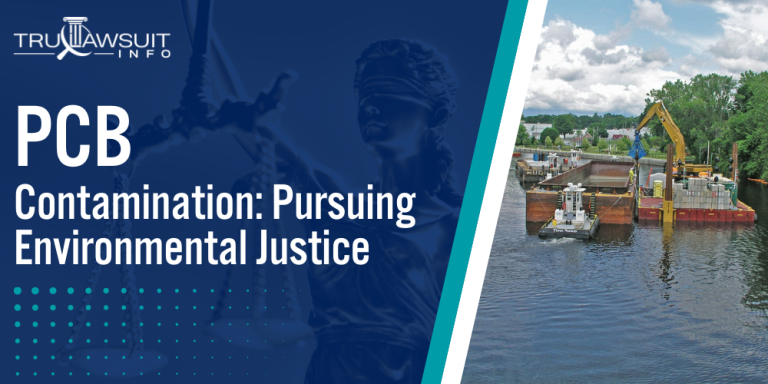
Intro To PCB Contamination
Here are the key aspects of PCB contamination:
- Environmental Persistence: PCBs are highly stable compounds that persist in the environment for long periods.
- Bioaccumulation: PCBs accumulate in the fatty tissues of living organisms, leading to higher concentrations up the food chain.
- Health Effects: Exposure to PCBs has been linked to various health issues, including cancer and developmental problems.
- Remediation Challenges: Cleaning up PCB contamination is a complex and costly process due to its persistence and spread.
If you or a loved one has experienced adverse health conditions after being exposed to PCB chemicals, you may qualify to pursue compensation.
Contact TruLawsuit Info using the chat on this page to receive an instant case evaluation to determine if you qualify to file a PCB lawsuit today.
Table of Contents
Emphasizing the Role of Environmental Justice in PCB Cleanup
The equitable distribution of environmental risks and benefits is central to environmental justice, especially in the remediation of PCBs (polychlorinated biphenyls), which haunt various communities.
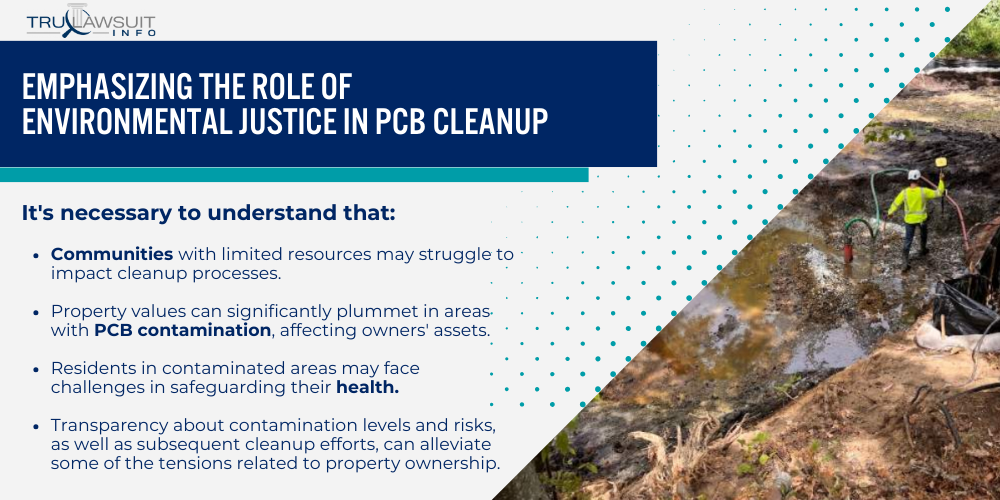
These communities often suffer due to prior use of PCBs in electrical devices and have a higher stake in ensuring their health and environment are protected.
Addressing Property Ownership in Contaminated Communities
Property ownership is a defining factor in how environmental hazards like PCBs are managed and who is affected most.
It’s necessary to understand that:
- Communities with limited resources may struggle to impact cleanup processes.
- Property values can significantly plummet in areas with PCB contamination, affecting owners’ assets.
- Residents in contaminated areas may face challenges in safeguarding their health.
- Transparency about contamination levels and risks, as well as subsequent cleanup efforts, can alleviate some of the tensions related to property ownership.
Utilizing FAST to Enhance Justice in PCB Cleanup Efforts
FAST (Facility Assessment and Screening Tool) is an innovative approach aimed at refining justice components in PCB cleanup processes.
Here’s why it’s advantageous:
- FAST assesses the risk of PCB exposure to prioritize remediation in vulnerable communities.
- The tool ensures a data-driven approach to protect human health.
- It helps channel resources to areas where cleanup can have the most meaningful impact.
- By incorporating community-specific information, FAST contributes to a more tailored and justice-focused cleanup strategy.
This method enhances accountability and ensures that efforts to reduce PCB exposure align with environmental justice principles.
Centering Equity in PCB Cleanup Site Characterization
When addressing PCB contamination, equity must be integrated into the entire cleanup process, especially during site characterization.
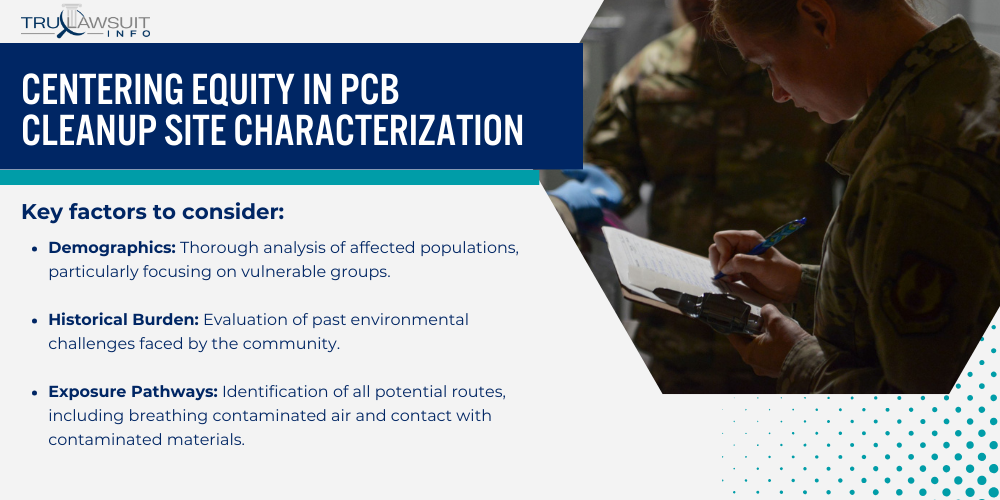
This involves acknowledging and responding to the communities most affected by hazardous waste and contaminated air to ensure that all individuals have equal protection and involvement.
Ensuring Environmental Justice in Pre-Cleanup Evaluations
Environmental justice mandates inclusive practices that identify and address disproportionate impacts on marginalized communities during PCB site assessments.
Key factors to consider:
- Demographics: Thorough analysis of affected populations, particularly focusing on vulnerable groups.
- Historical Burden: Evaluation of past environmental challenges faced by the community.
- Exposure Pathways: Identification of all potential routes, including breathing contaminated air and contact with contaminated materials.
- Community Engagement: Inclusive, transparent dialogue with community stakeholders to understand and address concerns.
By incorporating these factors, pre-cleanup evaluations can mitigate the risks of perpetuating environmental inequalities.
Crafting PCB Cleanup Plans with Justice at the Forefront
Cleanup plans should aim to remove hazardous waste effectively and prioritize the well-being of those historically burdened by contamination.
Steps to ensure justice-centric plans include:
- Risk Communication: Clearly convey potential hazards and remediation methods to the community.
- Cultural Competency: Tailoring cleanup efforts to align with the cultural and social contexts of the affected area.
- Resource Allocation: Proper distribution of resources to guarantee comprehensive cleanup without socio-economic discrimination.
- Health Monitoring: Ongoing health surveillance to trace any long-term effects stemming from PCB exposure.
A thorough approach to crafting justice-focused cleanup plans can lead to more successful and sustainable remediation efforts.
Transparent Certification Processes in Justice-Centric Cleanups
Ensuring transparency in the certification of safe PCB cleanup processes is another critical step in addressing environmental justice.
Elements of transparent certification processes include:
- Documentation: Easily accessible records of cleanup methodologies and results.
- Independent Verification: Third-party validation of the remediation to instill trust and confirm compliance.
- Clear Communication: Distribution of certification results in an understandable and actionable way for the community.
- Continuous Improvement: Incorporating feedback from stakeholders to refine and improve cleanup and certification methods.
Transparent certification fosters trust among the affected populations and contributes to the long-term health and safety of the community.
Financial Strategies: Environmental Justice in PCB Cleanup
Effective financial strategies are essential for ensuring environmental justice during the cleanup of PCB contamination.
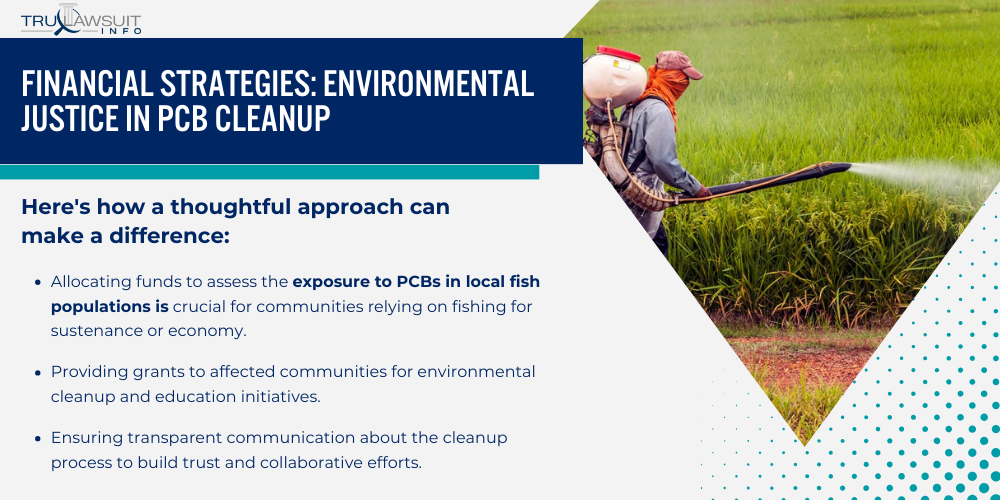
Addressing imbalances in economic resources can help alleviate health disparities caused by contaminated fish and exposed soils in historically disadvantaged communities.
Implementing PCB Cleanups with an Eye Toward Equity
Financial strategies should prioritize equity in PCB cleanups.
Here’s how a thoughtful approach can make a difference:
- Allocating funds to assess the exposure to PCBs in local fish populations is crucial for communities relying on fishing for sustenance or economy.
- Providing grants to affected communities for environmental cleanup and education initiatives.
- Ensuring transparent communication about the cleanup process to build trust and collaborative efforts.
- Targeting investment to build local capacity for long-term soil remediation and monitoring.
- Tailoring financing options to meet the specific needs of each impacted community.
By focusing on these areas, funds can be more effectively used to uphold the principles of environmental justice.
Adopting a Performance-Based Approach
Performance-based contracts can incentivize comprehensive and timely cleanups.
They require:
- Clear objectives based on reducing PCB levels in local environments.
- Baselines are established from a thorough analysis of commercial PCB mixtures and their impact.
- Measurable milestones for cleanup progress, ensuring accountability.
- Financial rewards are contingent on achieving specific environmental targets.
This approach aligns financial incentives with community health outcomes, promoting more effective remediation strategies.
Ensuring Insurance Fairness for Affected Communities
Insurance plays a vital role in managing the financial risks of PCB remediation.
To ensure fairness:
- Policymakers should advocate for insurance products tailored to the needs of affected communities.
- Insurance claims processes must be streamlined to address contaminated sites quickly.
- Coverage should extend to all aspects of cleanup, including long-term health monitoring.
- Community leaders should be involved in negotiating coverage terms to protect local interests.
With equitable insurance strategies, communities can be better equipped to manage the financial burdens of environmental cleanup and safeguard residents’ health.
Waste Management Contributions to Environmental Justice
Effective waste management practices are integral to environmental justice, especially when dealing with hazardous substances like polychlorinated biphenyls (PCBs).
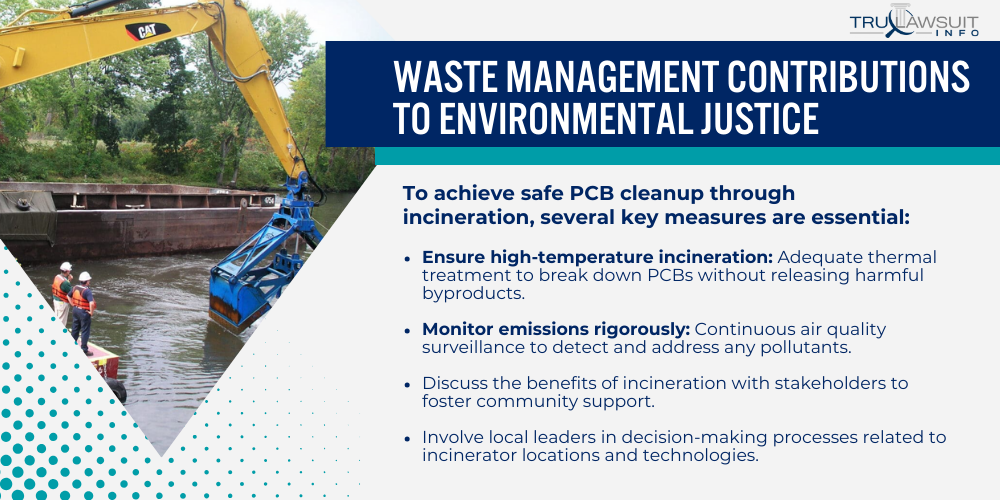
The management of PCB waste requires careful consideration to protect vulnerable communities.
This section explores the critical relationship between PCB waste management and environmental justice.
Advocating for Safe Incineration Practices in PCB Cleanup
Safe incineration practices must be a priority in PCB cleanup efforts to ensure the well-being of nearby communities.
It’s vital that municipal and industrial incinerators meet strict regulations to prevent further environmental and health risks.
To achieve safe PCB cleanup through incineration, several key measures are essential:
- Ensure high-temperature incineration: Adequate thermal treatment to break down PCBs without releasing harmful byproducts.
- Monitor emissions rigorously: Continuous air quality surveillance to detect and address any pollutants.
- Discuss the benefits of incineration with stakeholders to foster community support.
- Involve local leaders in decision-making processes related to incinerator locations and technologies.
Exploring Alternative Disposal Methods with Justice in Mind
Alternatives to traditional disposal methods should be considered to minimize the impact of PCB waste on underrepresented communities.
Different strategies can reduce harmful exposure through improper dumping and lessen environmental damage.
Here are some alternative disposal methods that prioritize environmental justice:
- Develop and promote eco-friendly cleanup technologies: Innovations that can neutralize PCBs without harming the environment.
- Prioritize the use of less invasive disposal methods that don’t concentrate waste in landfills.
- Invest in research for nature-based remediation to harness natural processes for decontamination.
- Foster partnerships with environmental justice groups to identify and implement preferred disposal practices.
Achieving Landfill Approvals with Community Involvement
Obtaining landfill approvals for PCB waste should include the voices of those who live nearby.
The focus lies in developing policies that reflect the community’s values and providing transparency every step of the way.
To achieve this goal, several key strategies can be implemented:
- Conduct community outreach campaigns: Inform residents about proposed landfill projects and their safety measures.
- Implement robust environmental monitoring systems to detect and address contaminants early on.
- Discuss the importance of PCB waste management to secure community buy-in.
- Develop contingency plans in collaboration with local health institutions, ensuring rapid response to any potential hazard.
Streamlining Facility Approvals for Equitable PCB Management
Efficient facility approval processes are key to managing PCBs effectively and equitably.
This includes ensuring that waste treatment and storage facilities adhere to the highest safety and environmental protection standards.
The following steps can be taken to streamline facility approvals for equitable PCB management:
- Standardize approval procedures to avoid delays in addressing PCB contamination.
- Transparency in communication: Sharing information on how facilities prevent the risk of improper PCB handling.
- Engage environmental justice representatives in the facility approval process.
- Establish clear criteria for community impact for all new PCB management proposals.
Risk-Based PCB Cleanup: Advocating Environmental Justice
Risk-based cleanup initiatives for polychlorinated biphenyls (PCBs) take on new importance when they intersect with the principles of environmental justice.
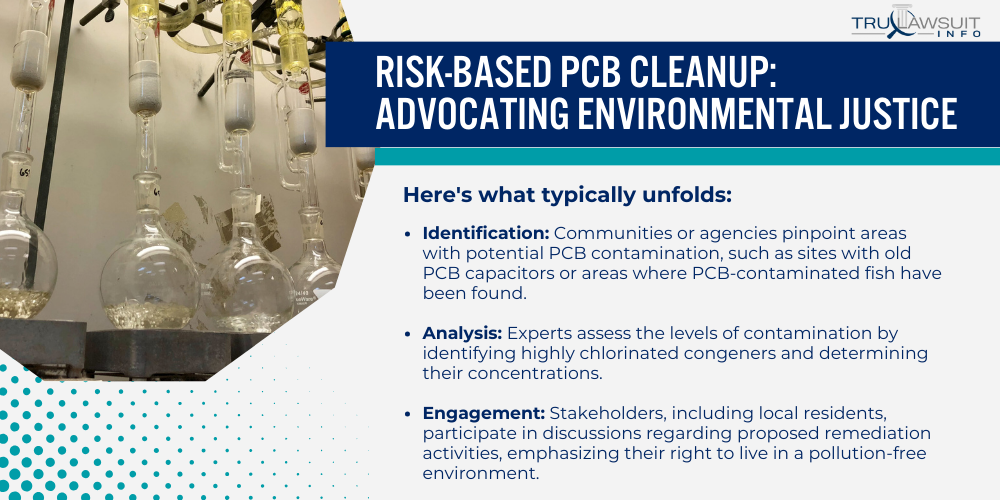
This cleanup strategy emphasizes both ecological health and human welfare, particularly in marginalized communities often affected by hazardous waste sites.
The PCB Cleanup Application Process for Community Benefit
Effective cleanup processes are built on transparency and accessibility.
A well-documented application process can ensure that impacted communities gain from remediation efforts tailored to their unique circumstances, particularly when dealing with PCBs in local environments.
Here’s what typically unfolds:
- Identification: Communities or agencies pinpoint areas with potential PCB contamination, such as sites with old PCB capacitors or areas where PCB-contaminated fish have been found.
- Analysis: Experts assess the levels of contamination by identifying highly chlorinated congeners and determining their concentrations.
- Engagement: Stakeholders, including local residents, participate in discussions regarding proposed remediation activities, emphasizing their right to live in a pollution-free environment.
- Action: Authorities implement cleanup strategies, which might involve removing or neutralizing PCBs. These strategies account for factors such as the number of chlorine atoms in the contaminants, which influence toxicity and persistence.
Managing Remediation Waste from Polychlorinated Biphenyls (PCBs) provides a framework that benefits communities by advocating for a cleaner, safer environment.
Influencing EPA Decisions with a Focus on Environmental Justice
Engaging with the EPA’s decision-making process is essential to ensure equitable treatment and protection for all communities.
Here’s how communities and advocacy groups can influence decisions:
- Submission of Comments: They can submit testimonies and comments during EPA’s proposal periods for new regulations.
- Data Sharing: Sharing data on local PCB contamination, including information about PCB-contaminated food, can influence remediation priorities and actions.
- Advocacy Groups: Community groups, often those in hazardous waste sites, can rally to present a unified stance on desired outcomes.
- Policy Change Campaigns: Campaigns aimed at policy change can hold the EPA accountable for incorporating environmental justice into their cleanup strategies.
Efforts in these areas lean on the EPA’s commitment to environmental justice, as detailed in the Policy and Guidance for Polychlorinated Biphenyl, which supports actions to prevent future contamination and addresses existing concerns.
Emergency Response to Environmental Justice in PCB Cleanup
Effective emergency response to PCB contamination demands a coherent strategy that addresses both environmental and social justice issues.
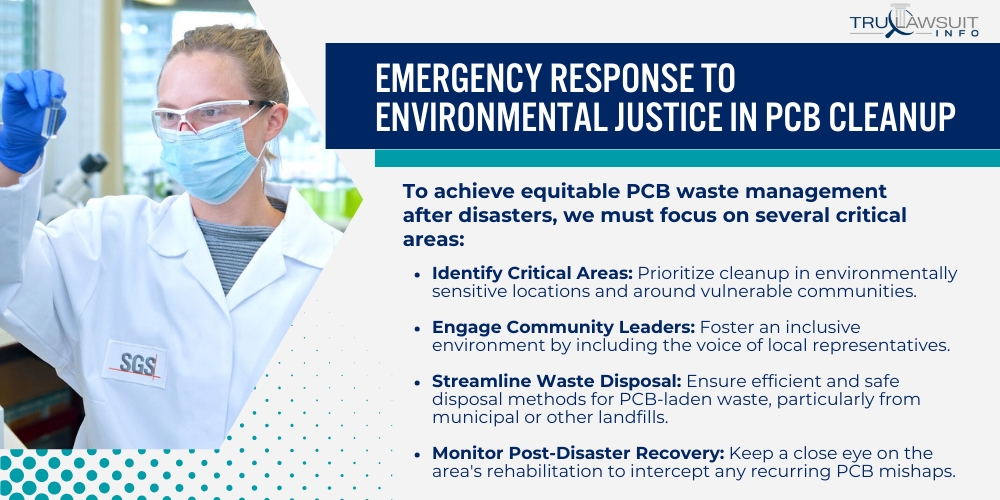
Equity remains at the forefront, ensuring that all communities, especially those historically overburdened by pollutants, receive thorough cleanup services and support.
Strategizing PCB Waste Management After Disasters with Equity
Swift management of PCB waste after disasters is essential to prevent further environmental damage and protect public health.
Strategies incorporated must be fair and considerate of all affected populations.
To achieve equitable PCB waste management after disasters, we must focus on several critical areas:
- Identify Critical Areas: Prioritize cleanup in environmentally sensitive locations and around vulnerable communities.
- Engage Community Leaders: Foster an inclusive environment by including the voice of local representatives.
- Streamline Waste Disposal: Ensure efficient and safe disposal methods for PCB-laden waste, particularly from municipal or other landfills.
- Monitor Post-Disaster Recovery: Keep a close eye on the area’s rehabilitation to intercept any recurring PCB mishaps.
PCB-Contaminated Electrical Equipment in Communities
Communities often inherit the legacy of outdated electrical transformers and other equipment contaminated with PCBs.
There’s a need to address such lingering hazards assertively:
- Mapping Hotspots: Carefully locate and chart areas with a high density of PCB-contaminated equipment.
- Educate Residents: Increase awareness about the risks of PCB exposure and safety measures.
- Initiate Removal Programs: Set up initiatives to remove and replace obsolete PCB-containing transformers with non-toxic alternatives.
- Collaborations for Clean-Up: Forge partnerships between government agencies, NGOs, and local bodies for comprehensive clean-up actions.
Environmental Justice in Enforcing PCB Cleanup Violations
Enforcing PCB cleanup regulations is not just a matter of environmental policy but also one of justice.
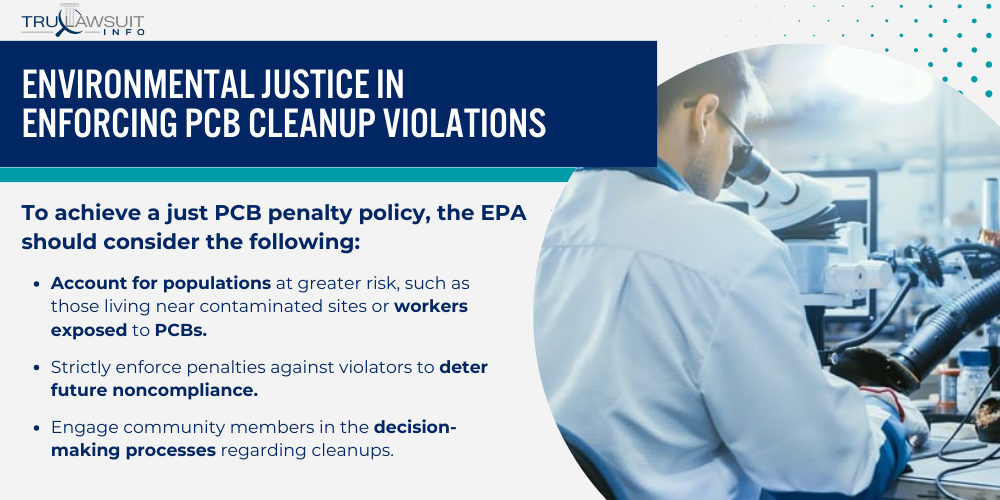
Environmental justice seeks to ensure that all communities bear the benefits and burdens of industrial activities equitably, which is particularly relevant to populations affected by PCB contamination.
Shaping EPA’s PCB Penalty Policy with Justice Principles
Environmental justice principles are shaping the way the EPA approaches PCB penalty policies.
The aim is to enforce regulations that do not disproportionately impact marginalized communities, which are often the hardest hit by PCB violations.
To achieve a just PCB penalty policy, the EPA should consider the following:
- Account for populations at greater risk, such as those living near contaminated sites or workers exposed to PCBs.
- Strictly enforce penalties against violators to deter future noncompliance.
- Engage community members in the decision-making processes regarding cleanups.
- Ensure timely and transparent communication with those affected by PCB pollution.
Promoting Fair and Consistent Penalties in PCB Violations
The EPA enforces penalties to promote not just compliance but fairness.
Penalties for PCB violations should be consistent, avoid creating disparate impacts, and reflect the seriousness of the violations, particularly when they involve sensitive issues like birth defects and exposure risks.
To ensure fair and consistent penalties, the EPA should consider the following factors:
- Establish baseline penalties that reflect potential health impacts.
- Assess the severity and duration of the violation to determine fines.
- Consider the violator’s history of non-compliance.
- Account for the cost of cleanup compared to the violator’s financial gains from non-compliance.
By incorporating environmental justice principles into the enforcement of PCB cleanup, the EPA aims to protect all populations from the health risks of PCB levels in the environment, particularly those historically disadvantaged.
This approach also seeks to ensure that producers of PCB-containing consumer products and industries using contained PCBs are held accountable for their environmental and public health role.
The Role of PCB Cleanup in Advancing Environmental Justice
Effective PCB cleanup programs are essential for reducing the disproportionate impact of environmental contamination on marginalized communities.
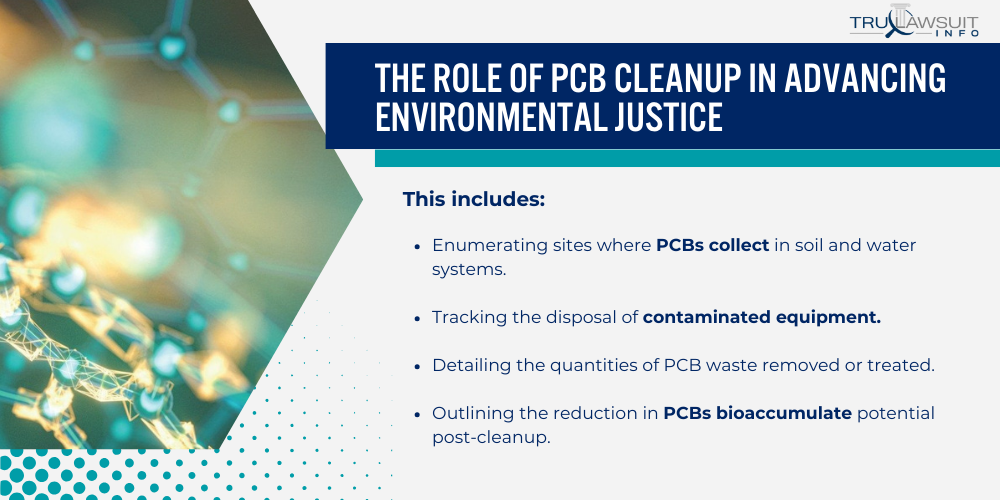
Mitigating the risks associated with PCB oil, PCB mixtures, and airborne PCBs plays a critical role in actualizing environmental justice.
Documenting PCB Waste Cleanup Efforts Equitably
Documenting cleanup efforts is a significant step toward transparency and accountability.
This includes:
- Enumerating sites where PCBs collect in soil and water systems.
- Tracking the disposal of contaminated equipment.
- Detailing the quantities of PCB waste removed or treated.
- Outlining the reduction in PCBs bioaccumulate potential post-cleanup.
For thorough documentation, EPA’s PCB Cleanup and Disposal Program maintains comprehensive data to promote equitable remediation.
Addressing PCB Contamination for Community Health
Communities exposed to PCBs face health risks such as immune system compromise and contamination of breast milk.
Cleanup initiatives must be prioritized:
- Reducing exposure to PCBs in residential areas.
- Monitoring and improving indoor air quality against airborne PCBs.
- Ensuring safe levels of PCBs in local food supplies.
- Maintaining unchanged PCBs at minimal levels to safeguard public health.
These targeted efforts aim to level the playing field for those in affected regions, especially as detailed by initiatives to manage PCB remediation waste.
Encouraging PCB Cleanups For Environmental Justice
Strides in environmental justice are often measured by the commitment to cleaning up naturally occurring and industrially produced PCB contamination.
Key actions include:
- Incentivizing the replacement of PCB mixtures in heat transfer fluids.
- Facilitating community involvement in decisions regarding PCB cleanup plans.
- Assessing the long-term benefits to the immune system and overall public health.
- Analyzing the environmental equity of cleanup operations, as in EPA’s examination of PCB cleanup BMPs seen in Greener Cleanups Best Management Practices.
Understanding the detrimental effect of PCBs on both the environment and public health drives the push for comprehensive cleanup endeavors.
Frequently Asked Questions
-
How do humans typically get exposed to PCBs?
Humans are typically exposed to PCBs through the consumption of contaminated food, especially fish and other seafood, which have accumulated PCBs from their environment.
Another exposure pathway is through inhaling air near contaminated sites or in buildings with PCB-containing materials.
-
What health effects can PCB exposure cause?
The health effects of PCB exposure can range from skin conditions such as chloracne to more serious issues, including cancer, immune system problems, and developmental disorders in children.
-
In what applications were PCBs historically used?
Historically, PCBs have been used in numerous applications due to their chemical stability and electrical insulating properties.
They were commonly found in PCB transformers, capacitors, and hydraulic fluids in electrical equipment.
-
What are common examples of PCB contamination in the environment?
Common examples of PCB contamination include PCB-contaminated soil, sediments, and concrete resulting from spills or leaks, and PCBs in river or lake sediments where they have been discharged or deposited over time.
-
What are the symptoms associated with PCB poisoning?
Symptoms associated with PCB poisoning may manifest as skin lesions such as rashes and acne-like eruptions and systemic effects like headaches, dizziness, and fatigue.
-
Why are PCBs considered toxic to human health and the environment?
PCBs are considered toxic because they are persistent organic pollutants that bioaccumulate in the environment and can cause a variety of adverse health effects, including cancer, immune disorders, and reproductive problems.

Experienced Attorney & Legal SaaS CEO
With over 25 years of legal experience, Jessie is an Illinois lawyer, a CPA, and a mother of three. She spent the first decade of her career working as an international tax attorney at Deloitte.
In 2009, Jessie co-founded her own law firm with her husband – which has scaled to over 30 employees since its conception.
In 2016, Jessie founded TruLaw, which allows her to collaborate with attorneys and legal experts across the United States on a daily basis. This hypervaluable network of experts is what enables her to share reliable legal information with her readers!
Have A Case?
Here, at Tru Lawsuit Info, we’re committed to helping victims get the justice they deserve.
To do this, we actively work to connect them with attorneys who are experts in litigating cases similar to theirs.
Would you like our help?
Tru Lawsuit Info is a reliable source of information about issues that may affect your health and safety, such as faulty products, data breaches, and environmental hazards.
Our team of experienced writers collaborates with medical professionals, lawyers, and advocates to produce informative articles, guides, and other resources that raise awareness of these topics.
Our thorough research provides consumers with access to reliable information and updates on lawsuits happening around the country. We also can connect consumers with attorneys if they need assistance.
Camp Lejeune's water contamination issue spanned several decades starting in the 1950s. Exposure to these chemicals has been linked to various serious health issues, including cancer, organ diseases, and death.
Research is increasingly suggesting a link between the use of Tylenol during pregnancy and the development of neurodevelopmental disorders, such as autism and ADHD, in infants.
Legal action is being taken against manufacturers of Aqueous Film-Forming Foam (AFFF), a chemical used in fighting fires. The plaintiffs allege that exposure to the foam caused health issues such as cancer, organ damage, and birth and fertility issues.
Have A Case?
Here, at Tru Lawsuit Info, we’re committed to helping victims get the justice they deserve.
To do this, we actively work to connect them with attorneys who are experts in litigating cases similar to theirs.
Would you like our help?

